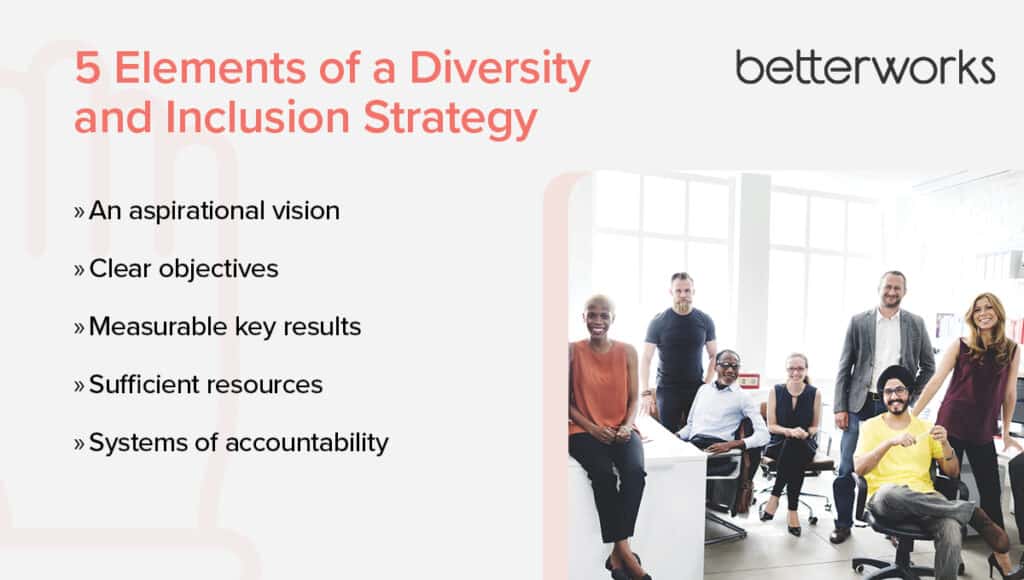Your business strategy is your organization’s roadmap, which is true for your diversity, equity, and inclusion efforts. Without a well-planned diversity and inclusion strategy, you’ll be hard-pressed to achieve meaningful change.
Organizations increasingly prioritize DEI, with 93% of companies saying DEI matters more than it did before the COVID-19 pandemic, according to a Heidrick & Struggles report. And more than 50% of respondents view DEI as a business imperative. The challenge for many organizations has been turning this attention and intention into tangible results.
Learn more about what D&I means in the workplace, how to establish winning diversity and inclusion strategies, and the companies that are making work better by example.
What exactly goes into workplace diversity and inclusion?
The past few years have seen many companies acknowledge the need for diverse and inclusive workplaces. But that doesn’t mean making meaningful, lasting changes is easy.
Strategic DEI efforts require executive sponsorship, consensus on metrics and accountability for achieving internal DEI goals, and a dedicated budget for driving change.
However, DEI isn’t always treated with the same degree of organizational commitment or value as other human resource work, says Dr. Stephanie J. Creary, an assistant professor of management at the Wharton School of the University of Pennsylvania and speaker in our People Fundamentals Series.
Creary, who studies how to create more inclusive and equitable workplaces through positive relational practices, argues that organizations need to develop organization-wide D&I initiatives with the full support of company leaders. Without leadership buy-in, HR leaders will struggle to implement D&I policies and programs due to a lack of resources and incentives for employee participation.
“For some people who only understand [DEI] as a personal experience and a personal perspective, it’s hard to make that leap to understanding it as a set of initiatives and valuable programs in a strategy that helps an organization to achieve not only its economic goals but also its social goals,” Creary shared in an interview with Betterworks.
Why is workplace inclusion important?
Diverse and inclusive workplaces align with business goals because they encourage talent development, higher productivity, better business results, and competitive differentiation.
For example, inclusive companies are more likely to unlock each employee’s full potential, contributing to higher productivity levels, employee engagement, and retention. Diverse and inclusive workplaces are more likely to develop psychologically safe work environments and company cultures. Direct results of psychological safety include better communication, retention, and team performance, a 2022 study by the Ecsell Institute found.
D&I strategies can contribute to overall business success, but DEI experts warn that HR leaders should be careful about overemphasizing that link. Researchers Oriane Georgeac and Aneeta Rattan found that overt declarations of diversity’s business or moral value could lessen employees’ comfort with such initiatives. “You don’t have to explain why you value innovation, resilience, or integrity. So why treat diversity any differently?” they write.
What is a diversity and inclusion strategy?
Once organizations set specific diversity and inclusion goals, they need an action plan for achieving them. Think of DEI strategy in terms of these five components:
- An aspirational vision. This vision is the ideal state you wish for your D&I strategy to achieve within your organization.
- Objectives. You need to set these goals in service of the larger vision.
- Key results. Achieving these outcomes indicates that you’ve made progress toward your objectives.
- Resources. These include the initiative’s budget, designated team leads, and programming.
- Accountability. D&I strategies should be tracked and reviewed to ensure that progress toward time-bound results is being made.
Your organization might also have drafted a DEI statement, which can help establish a baseline and state where you want to go. This statement can create direction for the subsequent strategy you produce.

How to improve diversity and inclusion in the workplace
One of the reasons to formulate a D&I strategy is to transform these values and ideals into tangible actions. These nine approaches can help your organization take intentional steps toward creating or improving diversity and inclusion initiatives within the workplace.
Make DEI part of your core company values
Broaden your organization’s core values to include DEI, demonstrating the importance leadership places on achieving positive DEI outcomes for the entire organization. These values can inform the further work of defining the behaviors that your company values and rewards.
From there, HR leaders can incorporate those behaviors into performance management processes and regular feedback conversations between managers and employees. Making DEI part of your core company values creates a diverse and inclusive workplace culture right from the start.
Challenge unconscious bias
We all have unconscious biases, but we can design processes to mitigate or challenge them. For example, blocking out personal identifiable Information and leaning into objective assessment results can help eliminate bias in the hiring process.
Structured, regular performance management conversations based on agreed-upon goals can also help managers overcome unconscious bias. Managers and employees build trust when they understand the other’s perspective, reducing the influence of unconscious bias.
Foster diverse thinking
Diversity is often discussed through the lenses of gender, race, sexual orientation, or cultural diversity, but an additional perspective is gaining traction — diversity of thought.
Neurodiversity is one area where diversity of thought comes into play. Embracing this type of diversity in hiring and performance management can infuse your workplace with new ideas and expand the available talent pool.
It’s also important to consider diversity of thought in terms of different backgrounds and lived experiences. The more demographically diverse employees in your workforce, the more likely you are to have diversity of thought.
Develop strong anti-discrimination policies
Promoting diversity and good behaviors is essential, but so is laying out clear consequences for anti-inclusive behaviors. These consequences often take the form of anti-discrimination policies. Many HR leaders stick closely to legal requirements when crafting these policies, but applicable laws and regulations are the floor — not the ceiling — of such efforts.
Spell out clear policies for what constitutes discrimination in different situations. This step is especially vital for anyone who makes people decisions, from recruiters selecting candidates to move down the funnel to managers deciding who to recommend for promotion.
Welcome remote and hybrid team members
Supporting remote or hybrid employees is a relatively new aspect of inclusion for many HR leaders. Hybrid workforces can be especially challenging if managers favor employees in the room with them and exclude remote teammates, which is known as proximity bias.
Instead, HR leaders can think about how to include employees regardless of location. This approach might require a redesign of workplace norms, meeting and communication structures, and workplace technologies to accommodate more diverse teams. Transparent processes can help everyone understand how to be inclusive, including managers with all-remote or hybrid teams.
Listen to your employees
The best source of inspiration for inclusive action is the workforce itself. Survey your employees regularly to take the temperature on inclusion — especially employee populations at the highest risk of exclusion.
An engagement survey platform like Betterworks Engage can help you gather this information from employees (while ensuring their privacy and anonymity), then aggregate the data to determine your next steps in building a diverse workplace.
Listening to your employees is vital. Employee feedback can inform HR leaders about what parts of their initiatives are working and any roadblocks.
Maximize opportunities for connection
Fostering a sense of connection between employees is essential to creating an inclusive working environment. When employees see each other as people, they can move beyond stereotypes or preconceptions. You can maximize these connections by hosting social events and bonding activities.
But you can also create direct points of connection within the workday, too. Consider asking employees to share public kudos for their team members for doing great work or exemplifying company values. Shared purpose fosters bonding opportunities, especially when employees work together towards common goals.
Encourage cultural celebrations
Openness to learning about other cultures and traditions is an integral part of creating an inclusive workplace culture. Build that into your processes by emphasizing options for religious leave.
Invite employees to bring their celebrations to work. Your LGBTQ+ employee resource group may host Pride festivities in June, for example, or particular ethnic or religious groups may wish to incorporate their traditions into the workplace. Such recognition and celebration can be done remotely, as well, if you have a hybrid or remote workforce. Provide notification of these activities during departmental and company all-hands meetings to re-emphasize the value of diversity.
Adopt inclusive language
More people are working remotely as part of global teams, which means your workforce could have a range of languages spoken in the workplace. HR leaders should be aware of the languages their employee population uses and make appropriate accommodations, such as with employee handbooks or other vital information.
One easy way to encourage all employees, including managers, to be inclusive in their daily work is to avoid metaphors and idioms that non-native English speakers might not understand.

3 great examples of diversity and inclusion in the workplace
When companies implement great diversity and inclusion strategies, it doesn’t remain a secret for long. These three businesses demonstrate what is possible with leadership buy-in, the appropriate resources, and an attitude that makes D&I a top organizational priority.
PwC
PwC CEO Tim Ryan has made improving diversity and inclusion part of his and the firm’s mission. Under his guidance, PwC has begun annual reporting on its inclusion efforts. The firm is intentionally transparent about its status and what it’s doing to address inequities in the workplace.
Adobe
Adobe is also transparent to stakeholders about its DEI efforts. The company makes its diversity data publicly available and has promised to maintain gender pay parity globally. In the U.S., Adobe has committed to pay parity among underrepresented minorities.
Paycor
Paycor has implemented a “STEP” program for achieving DEI outcomes in alignment with core principles of “Do the Right Thing” and “Take Care of Each Other.” The company also provides actionable resources for partners to improve DEI at their workplaces via its Perspectives+ library.
Successful DEI strategies drive positive change
DEI initiatives have known benefits for organizations, including better psychological safety, increased employee engagement, and lower turnover. It’s also the right thing to do.
But DEI success doesn’t happen on its own. You need intention, vision, values, and dedicated resources to prove that progress is a priority.
Incorporate diversity and inclusion strategies into your organization’s core values, supported by leadership and lived each day through well-designed processes. When D&I moves from idea to action, you can produce lasting change that elevates your organization and makes work better for employees.
Need more DEI guidance? Learn How to Write a Diversity, Equity, and Inclusion Statement.


